|
 Boletus leptospermi Boletus leptospermi
BiostatusPresent in region - Indigenous. Endemic
Images (click to enlarge)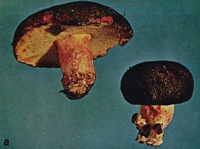
Caption: Fig. 8 - a, Boletus leptospermi (x1). | 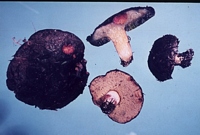
Owner: Herb. PDD | 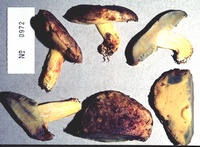
Caption: ZT0972
Owner: E. Horak: © Creative Commons Attribution-Noncommercial 3.0 New Zealand | 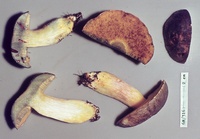
Caption: ZT68-316
Owner: E. Horak: © Creative Commons Attribution-Noncommercial 3.0 New Zealand | 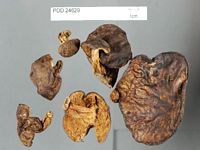
Caption: Dried type specimen
Owner: Herb PDD |
Article: McNabb, R.F.R. (1968). The Boletaceae of New Zealand. New Zealand Journal of Botany 6(2): 137-176 (http://www.rsnz.org/publish/abstracts.php).
Description: PILEUS: convex
to plano-convex, 4-8 cm diam., subtomentose and dry when young, subglabrous
to glabrous and slightly viscid in patches at maturity, mouse grey, reddish
brown, mahogany, or date brown with yellow patches and streaks, cherry red where
context is exposed by insects. Cuticle a fragmentary trichodermium when young,
becoming disorganised at maturity and composed of repent, sparingly interwoven,
septate hyphae with brown contents, terminal cells often irregularly inflated
to 12µm, frequently projecting at right angles to surface; margin entire. HYMENOPHORE:
tubes to 6 mm long, adnate or slightly excavated around apex of stipe, dull
yellow when young, becoming bright golden yellow at maturity; pores concolorous
with tubes or discoloured reddish brown in places, angular, 0.5-0.75 mm diam.;
bluing where damaged. STIPE: 3-5 cm long, equal or expanded basally, 1-2 cm
diam., stuffed or hollow at maturity, subglabrous to finely subvelutinate from
a close palisade of caulocystidia, faintly longitudinally striate apically,
concolorous with hymenophore or with red tints apically, reddish yellow at mid
point, typically bright red basally; flesh pallid yellow, bluing; annulus absent.
SPORES: spore print khaki (Tawny-Olive); spores melleous,
broadly elliptic-subfusiform, 8.4-10.8-01.5) X 4-5 µm, smooth. HYMENIUM: basidia
hyaline, clavate, 27-42 X 8-10.8 µm, 4-spored; cystidia numerous, scattered,
hyaline or brownish, obclavate to narrowly ventricose-rostrate, 39-60 X 6-11.5
µm. HYMENOPHORAL TRAMA: bilateral, of a modified Boletus subtype, mediostratum
strongly pigmented; clamp connections absent. CONTEXT OF PILEUS: pallid lemon
yellow, rapidly bluing on exposure to air, occasionally with red tints around
larvae tunnels. TASTE AND SMELL: not distinctive. CHEMICAL REACTIONS: KOH on
pileus and context of pileus—no reaction; NH4OH on pileus—no reaction; on context—blue.
Habitat: HABITAT: Solitary, gregarious, or caespitose under Leptospermum,
occasionally on rotten wood.
Notes: Boletus leptospermi displays a marked ecological preference for Leptospermum scrub
or forest containing L. ericoides. Field observations suggest that it
may form mycorrhizas with members of this genus.
Boletus leptospermi falls within sect. Subpruinosi as defined by Singer (1947). Of
the species included in this section, it appears to be most closely related
to a group of East Asian species, which includes B. nanus Mass. and B.
aureomycelinus Pat. and Baker, by reason of the short spores (Q=2 or less)
and disorganised trichodermium. However, in contrast to the latter species,
the basal mycelium of B. leptospermi is white instead of yellow. The
hymenophoral trama of B. leptospermi is not entirely typical of the Boletus
subtype for, although the mediostratum is heavily pigmented, the hyaline lateral
stratum is mixed rather than strongly divergent.
B. leptospermi is characterised by the multicoloured pileus, brightly coloured, subglabrous
to finely subvelutinate stipe, broad spores, and bluing hymenophore and context.
|